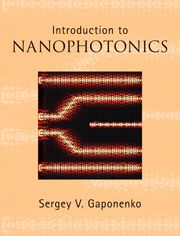Book contents
- Frontmatter
- Contents
- Preface
- Notations and acronyms
- 1 Introduction
- Part I Electrons and electromagnetic waves in nanostructures
- 2 Basic properties of electromagnetic waves and quantum particles
- 3 Wave optics versus wave mechanics I
- 4 Electrons in periodic structures and quantum confinement effects
- 5 Semiconductor nanocrystals (quantum dots)
- 6 Nanoplasmonics I: metal nanoparticles
- 7 Light in periodic structures: photonic crystals
- 8 Light in non-periodic structures
- 9 Photonic circuitry
- 10 Tunneling of light
- 11 Nanoplasmonics II: metal–dielectric nanostructures
- 12 Wave optics versus wave mechanics II
- Part II Light–matter interaction in nanostructures
- Author index
- Subject index
8 - Light in non-periodic structures
from Part I - Electrons and electromagnetic waves in nanostructures
Published online by Cambridge University Press: 05 June 2012
- Frontmatter
- Contents
- Preface
- Notations and acronyms
- 1 Introduction
- Part I Electrons and electromagnetic waves in nanostructures
- 2 Basic properties of electromagnetic waves and quantum particles
- 3 Wave optics versus wave mechanics I
- 4 Electrons in periodic structures and quantum confinement effects
- 5 Semiconductor nanocrystals (quantum dots)
- 6 Nanoplasmonics I: metal nanoparticles
- 7 Light in periodic structures: photonic crystals
- 8 Light in non-periodic structures
- 9 Photonic circuitry
- 10 Tunneling of light
- 11 Nanoplasmonics II: metal–dielectric nanostructures
- 12 Wave optics versus wave mechanics II
- Part II Light–matter interaction in nanostructures
- Author index
- Subject index
Summary
All periodic structures look alike. Every non-periodic object is essentially unique.
Unknown author.Since every non-periodic medium is in a sense a unique structure, it seems at first glance that there is no regularity to be traced with respect to light propagation in such a medium. However this statement is not correct. First, in non-periodic media with absence of any regularity, i.e. in random media, the definite laws of light propagation resulting from random scattering can still be evaluated. There are analogies with the length-dependent resistance (and conductivity) of a conductor, coherent backscattering and Anderson localization of light. Second, there are well-identified classes of aperiodic media featuring definite geometrical regularities. These are fractal media with self-similar geometry and quasi-periodic media. Certain regularities of light propagation through aperiodic media with well-defined geometrical algorithms have been discovered to date and are still an issue of current research. Finally, it will be shown there are certain conservation relations that are valid for all structures independent of their spatial organization. These issues will all be the subject of consideration in this chapter.
The 1/L transmission law: an optical analog to Ohm's law
Consider the propagation of light waves in a medium which contains randomly distributed scatterers. It is refractive index inhomogeneity that makes the light wave scatter. Scatterers may differ in shape, size and refractive index of material.
- Type
- Chapter
- Information
- Introduction to Nanophotonics , pp. 246 - 294Publisher: Cambridge University PressPrint publication year: 2010
- 2
- Cited by



